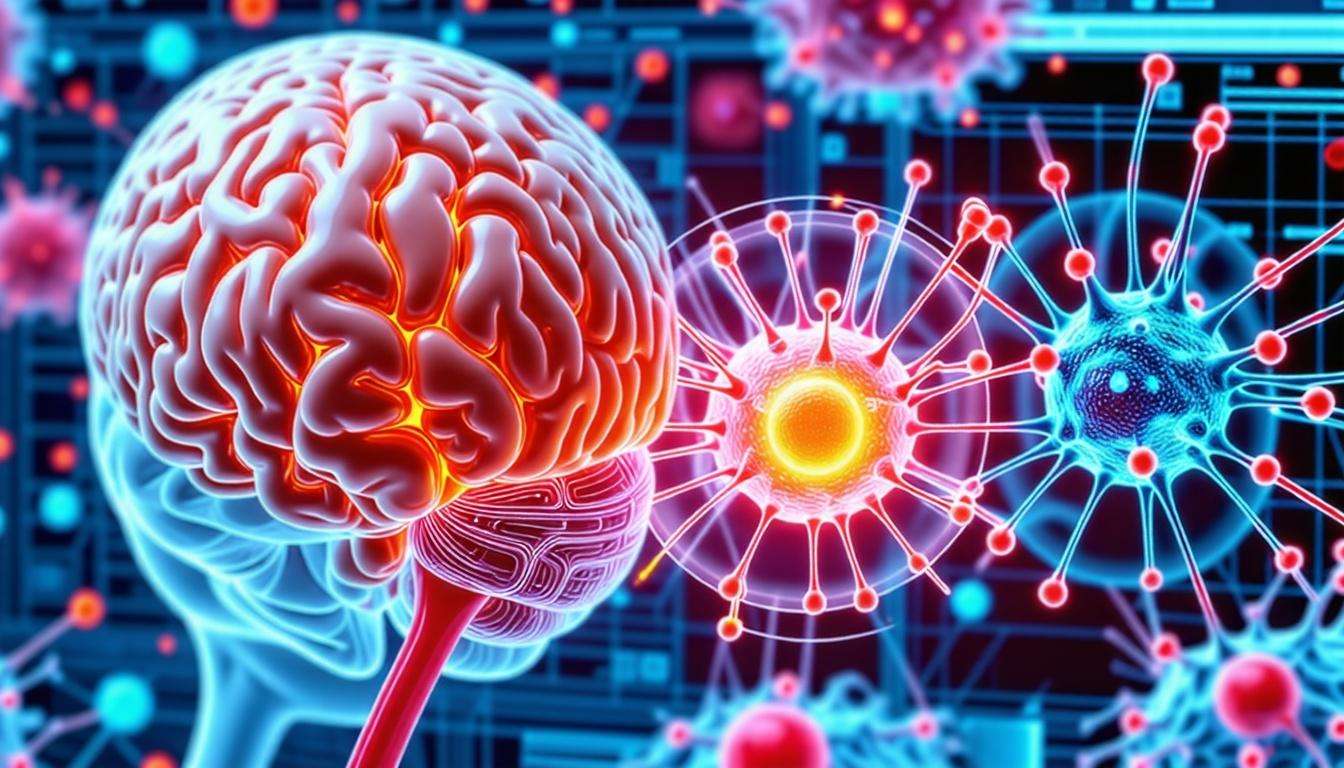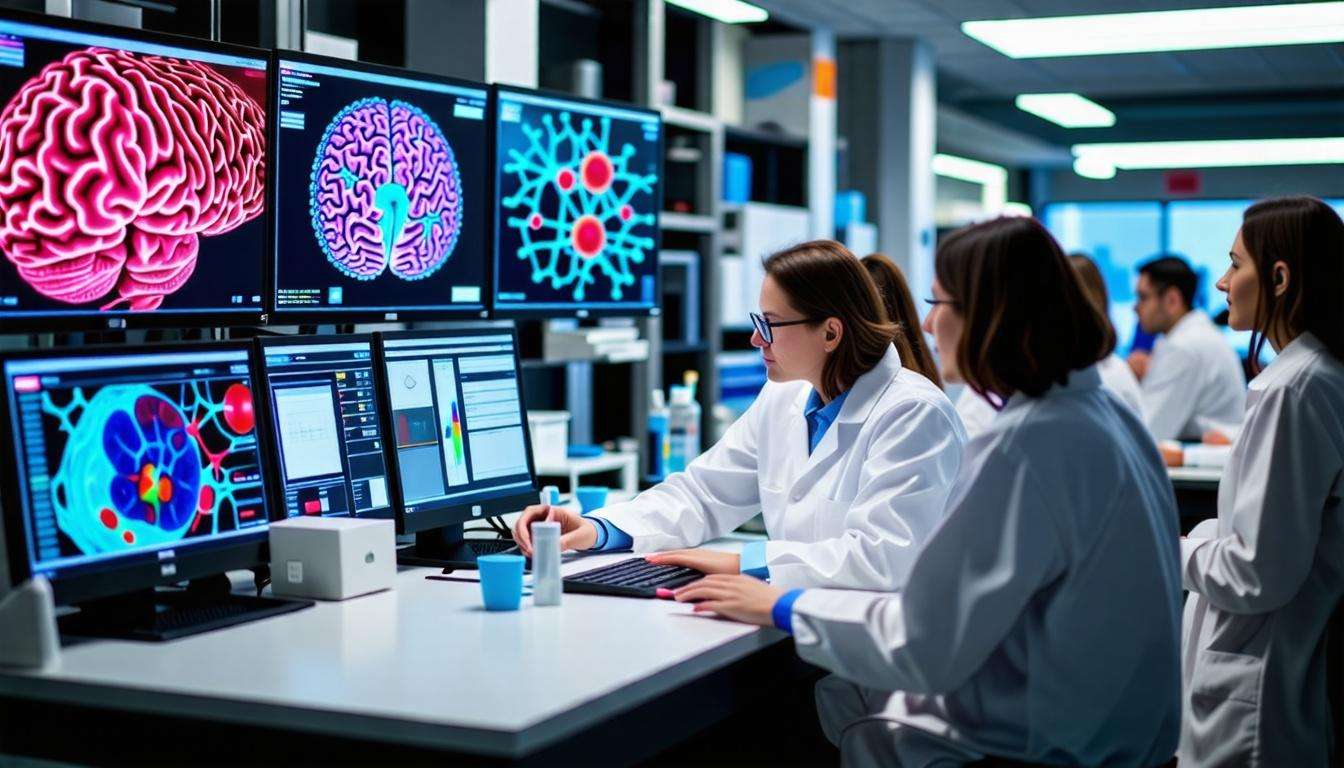Artificial Intelligence (AI) is transforming our grasp of cellular aging in the brain. Have you ever considered how our immune system influences brain health as we grow older?
Recent studies indicate that T cells, a type of immune cell, accumulate in the brain over time, potentially speeding up aging in surrounding brain cells. Researchers at Stanford University are leveraging AI and state-of-the-art techniques like spatial transcriptomics to investigate these critical interactions and their implications for aging.
This pioneering research illuminates the complexities of brain health and paves the way for innovative strategies to improve it. By uncovering these cellular dynamics, we can develop methods to support our brains as we age, fostering a healthier future.
Key Takeaways
- AI and spatial transcriptomics are pivotal in uncovering how cellular interactions influence brain aging.
- With age, T cells infiltrate the brain, igniting inflammation that accelerates the aging of surrounding cells.
- Distinct brain cell types can either accelerate or decelerate aging, highlighting the complex network of cellular connections.
- State-of-the-art research leverages AI to find innovative approaches for brain repair by enhancing our comprehension of aging.
Role of AI in Analyzing Cellular Aging Mechanisms

The role of AI in analyzing cellular aging mechanisms is like having a genius detective on our research team. Just as detectives piece together clues to solve mysteries, AI enables scientists to decode why some brain cells age faster than others. At Stanford University, researchers use spatial transcriptomics—mapping gene activity within cells—to show these critical secrets.
Imagine the brain as a busy city, where each cell is a unique building. AI acts as a detailed map, showing how these buildings interact. Through single-cell analysis, we can observe how different cells, especially T cells, influence the aging process. As we age, T cells multiply, affecting neighboring cells in surprising ways.
By leveraging machine learning and bioinformatics, researchers are identifying aging biomarkers and patterns that reveal cellular changes over time. This knowledge enhances our understanding of neural aging and paves the way for boosting cellular resilience and longevity.
| Cell Type | Effect on Aging |
|---|---|
| T Cells | Pro-aging effect |
| Neural Stem Cells | Pro-rejuvenating effect |
By merging data analysis with experimental techniques, we are on the brink of revolutionary discoveries in aging research. The fusion of AI and biology is transforming our understanding of biological aging, making the future of neuroscience more exciting than ever!
Spatial Transcriptomics and Its Contribution to Brain Aging Research

Spatial Transcriptomics acts as a detailed map of the brain, allowing scientists to investigate how different cells age. Imagine walking through a city and observing how each neighborhood transforms over time; this is what researchers at Stanford University are doing with brain cells! By leveraging AI and machine learning, they uncover the complex ways cells communicate and influence each other as they age.
Through single-cell analysis, they’ve found that certain immune cells, called T cells, can speed up aging in nearby cells, while neural stem cells have the power to rejuvenate them. It’s like having friends who either increase your energy or sap it away! This research reveals the gene expression patterns associated with aging and highlights the critical role of the tissue microenvironment in preserving brain health.
With transcriptomic analysis, scientists are mapping these cellular interactions, vividly illustrating how neurodegeneration occurs. By identifying aging biomarkers, they aim to create innovative treatments and interventions to combat age-related decline. This represents a significant leap in neuroscience, paving the way for future breakthroughs that could transform our understanding of brain health.
Machine Learning Techniques for Single-Cell Sequencing in Neuroscience
At Stanford University, researchers are using AI and Spatial Transcriptomics to explore why some brain cells age faster than others. Imagine the brain as a busy city, where each cell is a unique building. Understanding their interactions is like finding your way a complex network of streets and alleys. Through machine learning techniques, we analyze single-cell sequencing data to open up the mysteries of cellular aging.
These advanced bioinformatics methods allow us to visualize gene expression patterns across different brain regions. Think of it as using a high-tech camera to capture the city’s layout in stunning detail. This approach helps scientists identify aging biomarkers and track the evolution of neural cells over time.
- Cell Differentiation: Machine learning algorithms categorize cells based on their distinct traits.
- Tissue Mapping: Spatial transcriptomics provides a complete map of cellular interactions.
- Data Analysis: High-throughput sequencing generates massive datasets, revealing complicated aging processes.
By harnessing these techniques, we gain critical insights into age-related changes and may devise strategies to combat neurodegenerative diseases. Isn’t it interesting how technology illuminates the secrets of our biology?
Impact of Neural Cell Interactions on Aging Processes
Have you ever thought about how brain cells communicate and influence aging?
Researchers at Stanford University are uncovering this mystery using AI and spatial transcriptomics. They’ve found that some brain cells age faster than others, much like certain trees flourish in different environments.
In their groundbreaking research analyzing gene expression across millions of brain cells, scientists found that T cells can hasten the aging of nearby cells. Picture T cells as noisy neighbors disrupting the peace of a quiet street. On the contrary, neural stem cells act like a new breeze, revitalizing their surroundings. This revolutionary research highlights the critical role of these interactions within the brain microenvironment.
By mapping these interactions, researchers can identify aging biomarkers, akin to signposts that guide us through the aging process of our brains. This approach sheds light on neurodegeneration and opens doors to potential therapies aimed at enhancing brain health and fighting age-related diseases.
Understanding the dynamics of neural cell interactions could reveal secrets to a healthier, longer life. Isn’t it interesting how small interactions can profoundly impact our in general well-being?
Identifying Biomarkers for Aging in Brain Tissue Analysis
At Stanford University, researchers are looking closer into the complex world of cellular aging using advanced techniques like spatial transcriptomics and AI. Imagine the brain as a busy city, where each cell is a unique building with specific roles. But why do some structures crumble faster than others?
This is where biomarkers come in—think of them as the critical signs of our cellular cityscape.
By leveraging machine learning and single-cell analysis, scientists can map gene expression in brain tissue, revealing the aging patterns of different cells. For example, T cells act like emergency responders, sometimes speeding up aging in nearby cells. Conversely, neural stem cells serve as skilled architects, revitalizing their surroundings and fostering cellular health.
This pioneering research enhances our understanding of neurodegeneration and opens doors to innovative therapies aimed at boosting brain health. By identifying these aging biomarkers, we gain critical insights into maintaining the integrity of our brain city as we journey through the aging process.
Integrating Bioinformatics with Experimental Techniques in Aging Studies
Integrating bioinformatics with experimental techniques in aging studies is like combining a treasure map with a compass. At Stanford University, researchers use AI and spatial transcriptomics to decode the secrets of how brain cells age at different rates. By analyzing gene expression at the single-cell level, we reveal unique aging patterns, much like how a tree’s rings narrate its history.
Imagine the cellular aging process as a race: some cells sprint ahead while others lag behind. This is where machine learning excels, helping us identify aging biomarkers that signal when cells start to slow down. With tools like AI diagnostics, we gain valuable insights into the complex interactions among different brain cell types.
Through advanced data analysis and molecular biology, we map how these interactions affect neural cells and contribute to cognitive decline. By synthesizing these findings, we can develop targeted therapies that rejuvenate aging cells, potentially reversing some effects of aging. This pioneering research not only enhances our understanding of neurobiology but also opens doors to future breakthroughs in aging studies.
Advancements in Computational Biology for Understanding Cellular Metabolism and Aging

At Stanford University, researchers are opening the mysteries of cellular aging using state-of-the-art AI and Spatial Transcriptomics. Imagine our cells as busy factories, each necessary to our body’s functions. What happens when these factories start to break down?
Here, AI steps in as a detective, examining how different cells age at varying speeds.
Through advanced single-cell analysis, scientists craft detailed maps of gene expression in brain cells—similar to mapping a city to highlight thriving neighborhoods versus those in decline. By identifying aging biomarkers, they uncover critical factors that accelerate aging in specific cells. For instance, researchers found that neural stem cells can rejuvenate their neighbors, much like a mentor inspiring younger students.
With machine learning powering these discoveries, we are paving the way for innovative treatments that could slow the aging process. As we explore into into computational biology, we are not just observing aging; we are actively working to understand and potentially reverse it.
Summing up
AI is transforming our grasp of cellular aging in the brain. Researchers at Stanford are leveraging AI and spatial transcriptomics to reveal why some brain cells age faster than others. This pioneering research deepens our understanding of brain health and paves the way for interventions that could decelerate the aging process. Picture a future where enhanced brain health is accessible to all—this is the exciting potential of these innovations.




